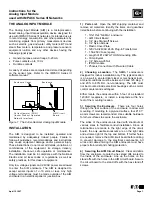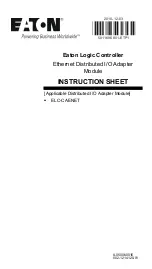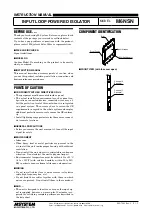
13
J355HA M50
12
532141 - Rev. A
16
1
3
2
5
4
5
Tr
ansla
tion of the original instruc
tions
ENGLISH
2.7 EFO (EMERGENCY FAST OPERATION -
OPTIONAL)
The bollard J355HA M50 can be equipped with an EFO (Emergency
Fast Operation) emergency activation system, which can be activated
at any time to raise the cylinder immediately. The EFO system consists
of a tank, a pressure switch and a solenoid control valve powered by
230V ~
In order to connect the solenoid valve (this varies depending on the
N.O. / N.C. option adopted), refer to
13
, terminals 4 and 5.
The N.O. solenoid valve (“Blackout” model) enables the EFO to be
activated, both on the command of the operator and in the event of
a power failure, while the N.C. version only allows for the voluntary
activation of the device.
2.8 MANUAL OPERATION (OPTIONAL)
In order to manually lower the bollard, use the release device in ac-
cordance with the following guidelines:
1. Unscrew and remove the six M8x40 screws that secure the top
cover in place (
12
).
2. Remove the top cover.
3. Unscrew and remove the four TORX T30 screws securing the cover
of the
hydraulic control unit
in place (
13
-
1
).
4. Remove the cover of the
hydraulic control unit
.
5. Unscrew the lock nut
13
-
2
and loosen the screw
13
-
3
to move
the cylinder downwards.
2.9 AUTOMATIC OPERATION
To restore automatic operation:
1. Turn the screw
13
-4 until the stop point in order to restore
automatic operation.
2. Tighten the lock nut
13
-
5
3. Reposition the hydraulic control unit cover and fix in position using
the TORX T30 screws (
13
-
1
)
4. Reposition the top cover and fix in position using the M8x40
screws (
12
).
2.10 MAINTENANCE
The standard sequence of routine maintenance is as follows:
1. Clean the pit by sucking out any deposited material
2. Clean the water drainage systems at the bottom of the pit
3. Check and if necessary rectify any oil leaks from the movement
piston
4. Carry out a general check to ensure that the bollard screws are
correctly tightened
5. Carry out a general clean of the moving cylinder and touch up
any paintwork
6. Check the hydraulic control unit, topping up the oil level
7. Check to ensure the EFO system is functioning properly


































